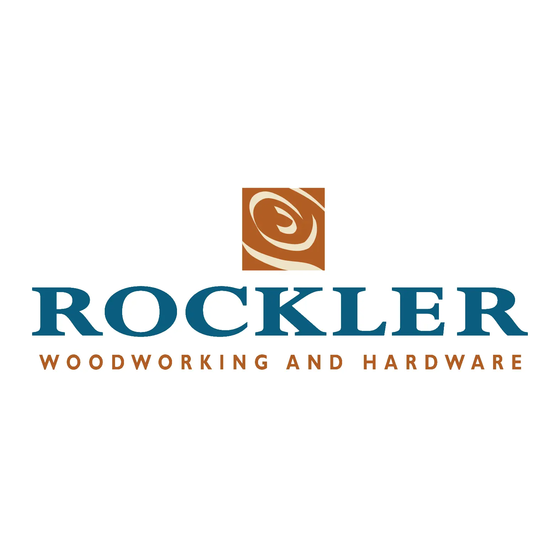
Advertisement
Quick Links
F
B
G
L
PARTS list - Router Table ProFence
A Aluminum Fence
B Adjustable MDF Fence Faces
C Bit Safety Guard
D Dust Port
E 3/8-16 T-Knobs
F 5/16-18 x 11/4" T-Bolts
G 1" Round Knobs
H Knob Spacer
I 3/8-16 x 2
⁄
" Hex Bolt
1
2
J 3/8-16 x 2
⁄
" Carriage Bolt (Use with ProPhenolic Router Table)
3
4
K 3/8" Nylon Washer
L Jointer Bars
E
H
A
J
I
F
G
Router Table
ProFence Instructions
G
G
F
K
C
B
D
G
E
H
F
I
Quantity
G
J
1
2
1
1
2
6
6
2
2
2
2
2
1
Advertisement

Summary of Contents for Rockler ProFence 47905
- Page 1 Router Table ProFence Instructions PARTS list - Router Table ProFence Quantity A Aluminum Fence B Adjustable MDF Fence Faces C Bit Safety Guard D Dust Port E 3/8-16 T-Knobs F 5/16-18 x 11/4" T-Bolts G 1" Round Knobs H Knob Spacer I 3/8-16 x 2 ⁄ " Hex Bolt J 3/8-16 x 2 ⁄ " Carriage Bolt (Use with ProPhenolic Router Table) K 3/8" Nylon Washer L Jointer Bars...
- Page 2 Feed Direction Router top (top view) Always feed the workpiece against the cutter rotation, as shown in Figure 1. Feeding the workpiece with the cutter rotation is called “climb cutting”. Climb cutting is very Router bit rotation dangerous, because the cutter will grab the workpiece and thrust it the same direction as the cutter rotation. Even small router bits will overpower your ability to hold onto Fence the workpiece during a climb cut. Do not use this router table until you understand Workpiece proper feed direction and bit rotation. If climb cutting is still unclear, ask your retailer for help, give us a call, or reference a book on router table usage. CAUTION: NEVER CLIMB CUT! Proper feed direction Fig. 1 - A typical setup. Here, the fence is partially Avoiding Fence Traps covering the router bit. Fence traps occur when the work piece is fully “trapped” between the router bit and fence. Fence traps pose two real concerns: the possibility of climb feeding, and human AVOID! exposure to the router bit. As stated earlier, climb cutting should be avoided as loss of control of the operation is a possibility! Fence Figure 2 shows a classic trap to be avoided. What appears as a normal feed direction (working from right Workpiece to left) is wrong, and will instead produce a climb cut. Because the work piece is trapped it can easily be pulled from one’s grip and thrown with great velocity. Feeding the stock from left to right will eliminate the climb cut but Bit rotation Proper feed not the danger. It will be difficult to keep the stock tight direction against the fence as the bit’s rotation will thrust the stock away from the fence. Also, your body will be dangerously exposed to the spinning...
- Page 3 B. “Zero Clearance” Setting Cutting the subfences into the router bit profile produces “zero clearance”. Zero clearance eliminates the gap between the fence and router bit. This prevents the workpiece from getting pulled into the fence just before the router bit. Moreover, a zero clearance setting achieves a cleaner cut because the subfence supports the workpiece fibers. If a true zero clearance setting is desired, follow these steps: 1. Adjust the bit height and fence position. Note: The subfences must NOT contact the router bit at this time. 2. Install the bit guard and secure. 4. Start router, and use dust collection. From the back of To reset the subfence position, loosen the 4 knurled the fence, slightly loosen the subfence knobs and knobs on the back and slide subfence into desired carefully slide the infeed subfence into the spinning position. Be sure to retighten all knobs prior to using. router bit. Hold onto the subfence knobs. 5. After the subfence has reached the guide bearing of Router bit guide bearing the router bit, fully tighten the knobs on the subfence. Note: If the bit does not have a guide bearing (i.e. Outfeed Infeed vertical raised panel bits), slide the subfence half-way subfence subfence into the bit, then tighten the subfence knobs. Caution: Never adjust or slide the subsfences from the front! Always work from the back with The infeed subfence is wide open, and the outfeed both hands on the adjustment knobs. subfence is set to "close". Important Notes: The outfeed subfence is rarely set to zero clearance, because doing so has little performance benefit and can Outfeed subfence Infeed subfence...
- Page 4 5. Safe operation requires a router table fence, bit guard, dust replace any damaged parts. 11. Disconnect the power before moving, adjusting, or repairing collection system, starting pin or fulcrum, and speed reducer for large diameter bits. We recommend reducing router speed parts, or otherwise maintaining your router table and any for 1" or larger diameter bits. Consult your bit manufacturer accessories you may be using. 12. Keep children, pets, and those who may disregard safety away for the exact speed. 6. Use the right tool for the job. Do not force a tool or attachment from work area, cords, sockets and tools. to do a job for which it was not designed. 13. Wear snug fitting clothes and keep long hair back to avoid 7. Secure your work with a featherboard, clamps, or a vice catching in moving parts. 14. Do not overreach. Maintain balanced footing and stance. when appropriate. The use of inappropriate accessories 15. Stay alert. Use common sense. may cause injury. 47905 Rev 08/12 Distributed by Rockler Companies, Inc. ©2012 Rockler Woodworking and Hardware...









Need help?
Do you have a question about the ProFence 47905 and is the answer not in the manual?
Questions and answers